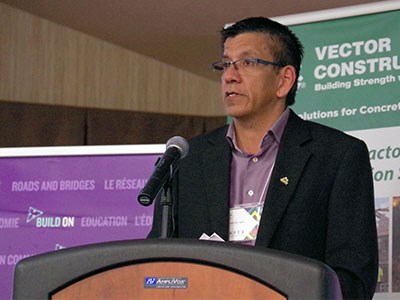Partnerships between Indigenous communities and the private sector should incorporate both business and community development aspects if they’re going to be successful, said an executive with Fort William First Nation.
Ian Bannon, director of property and lands management with Fort William First Nation (FWFN), told the Aboriginal Partnership Exchange conference in Thunder Bay in June that any partnership talks should start with a simple question: what’s needed?
“It’s putting the needs of the community on the table, and the struggles of the community on the table, as well, and asking those partnerships, ‘How can you help us?’” Bannon said during a panel discussion titled Partnerships Between First Nations and Industry Best Practices.
Bannon was joined by Adam Rose, engineering manager with True Grit Consulting, and Craig Batten, regional human resources manager with Resolute Forest Products, for the hour-long talk.
“We don’t come to the table experienced, educated and with all of those required skills,” Bannon said. “We don’t — let’s face it. We learn because we’re working with our partners.”
Bannon said for FWFN, any partnerships must benefit the community’s members.
“We must be able to provide
opportunities for our communities to become sustainable and
self-sufficient,” he said. “We must be able to ensure that
employment opportunities are generated and provided to our members.
We must ensure appropriate training is provided, along with
job-readiness programs.”
Bannon offered Oshki-Aki LP, a
partnership between Thunder Bay-based True Grit Consulting and FWFN,
as a case study.
Oshki-Aki was formed in 2011, and has allowed FWFN to undertake a number of large, capacity-building projects in the community, including the design and construction of new powwow grounds, drainage improvements, the construction of a new office complex, and the complete rehabilitation of Mission Road, one of FWFN’s main roadways.
Further, with technical and administrative support from True Grit, FWFN has been able to move into a project management role and bid on large government, mining and energy projects in Ontario, Bannon said.
“The partnership arrangement has allowed Fort William First Nation to think big,” Bannon said.
But there’s more to Oshki-Aki than the physical projects themselves. The partnership has also created opportunities for FWFN members.
“We’ve had surveyors, lab technicians, environmental monitors, and co-op students integrated from Fort William First Nation members into the company,” Rose said.
The importance of creating such opportunities was also addressed by Batten, who said Resolute has seen success with a pilot program that focusses on attracting more Aboriginal students into the skilled trades field.
“We are trying to work at bringing this to western Ontario,” Batten said. “It’s been established for the last six years in most of the eastern colleges, from Timmins all the way down to Sarnia.”
The program, Batten said, is vital for Resolute, as there is still a shortage in skilled tradespeople, such as the industrial millwrights and industrial electricians the company requires to keep its equipment running.
“As prevalent as you think Canada is as a resource country, there is definitely a need for more trades, especially in the millwright and electrical field, and that’s not going to change,” Batten said.
As for getting a partnership off the ground with a First Nation community, Rose said it’s a simple matter of picking up the phone and talking about the community’s specific needs.
“Get that conversation going,” Rose said. “What do you need, what are you looking for, how can we help support? It’s as simple as that.”
The process does get more in-depth once those initial talks take place, of course, he said. In the case of Oshki-Aki, there were extensive talks about FWFN’s needs, and then a plan to meet those needs into the future was developed.
“When we first structured this business, we had a lot of dialogue about that, and about what it can do,” Rose said. “What are the capabilities? And once, I think, the table understood those capabilities, then the wheels started turning around, the business opportunities and where it could go.”
Bannon said it’s important to keep in mind that each party in a partnership needs each other to be successful.
“Although there are many First Nations entering into partnership agreements, each will tell you that establishing a positive working relationship is essential,” he said. “Establish your respect and your trust with each other.”




